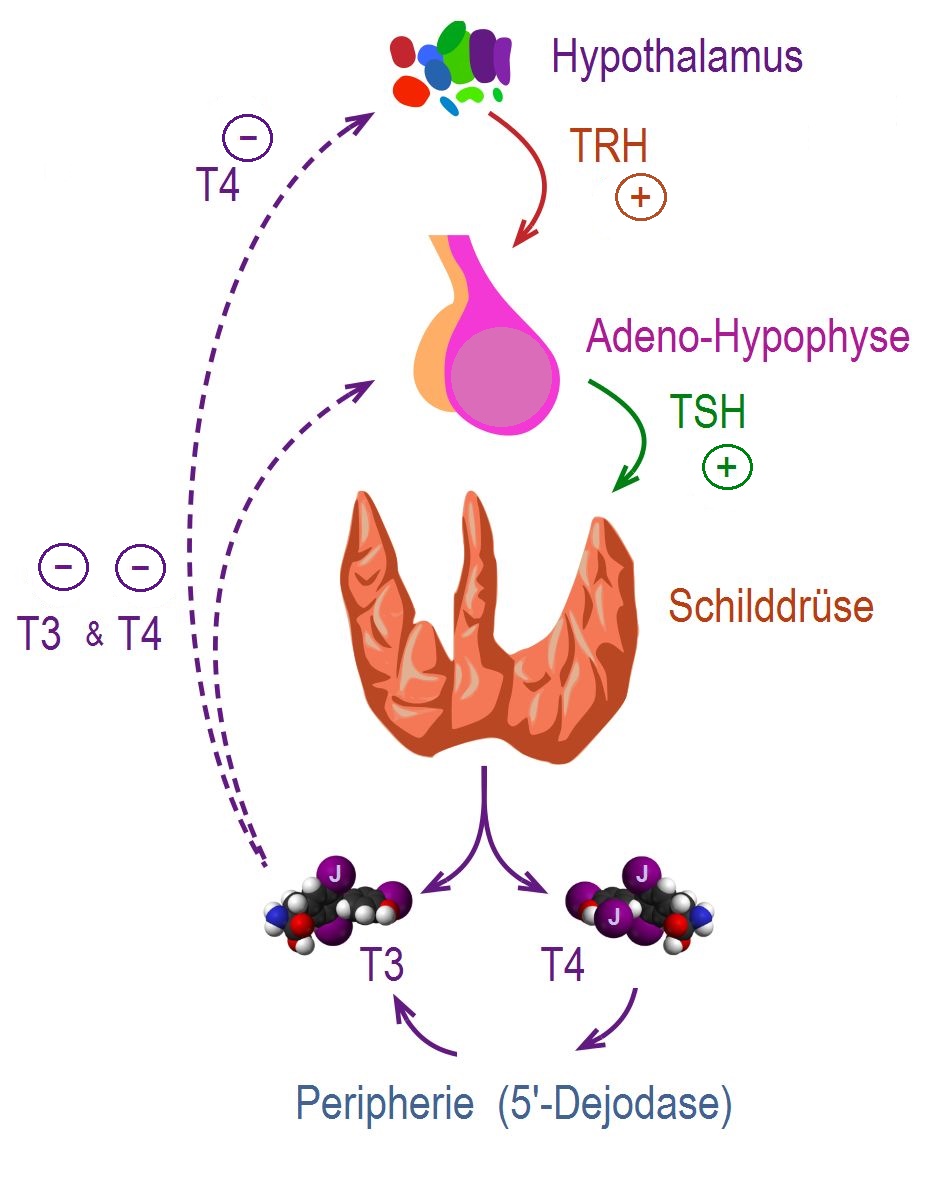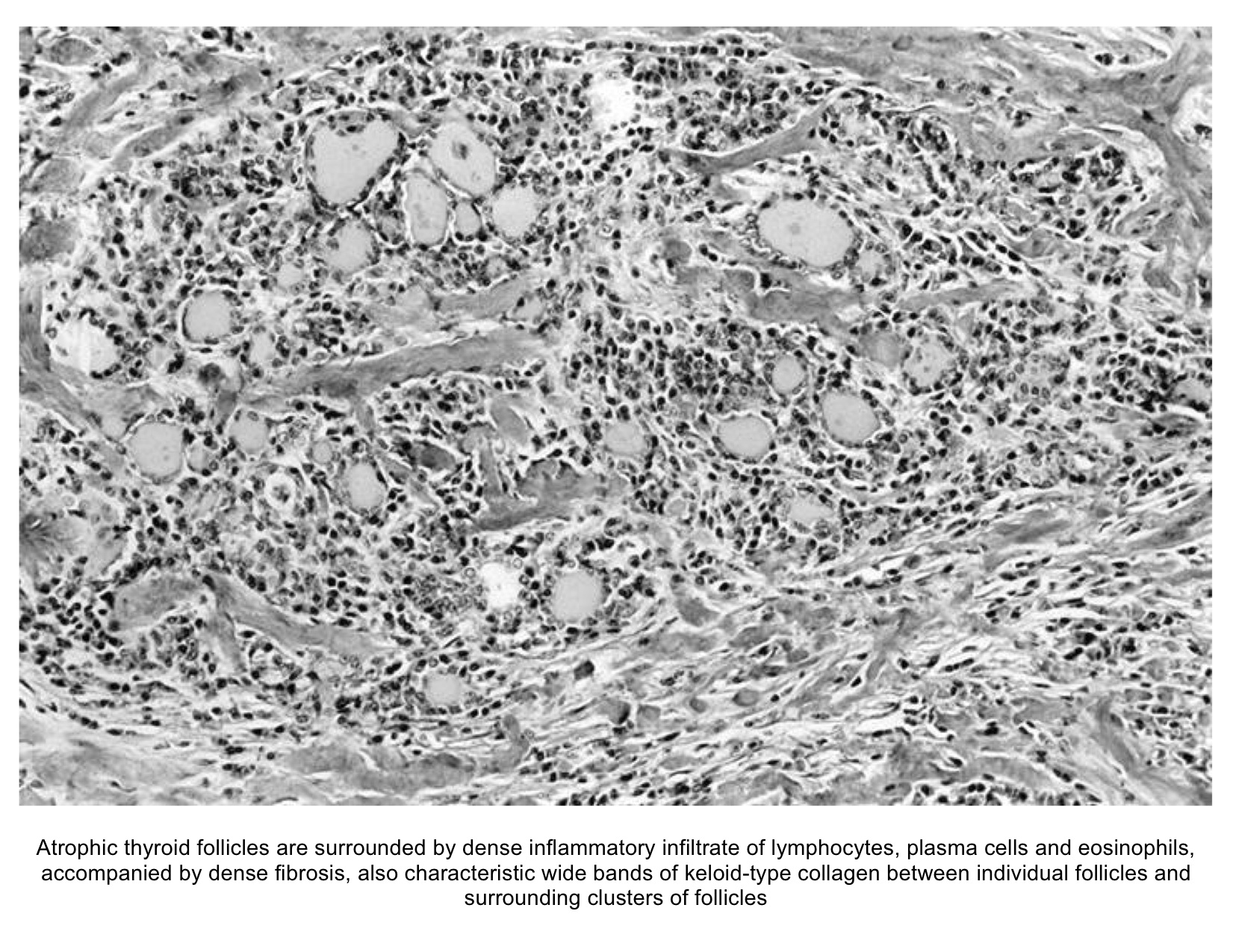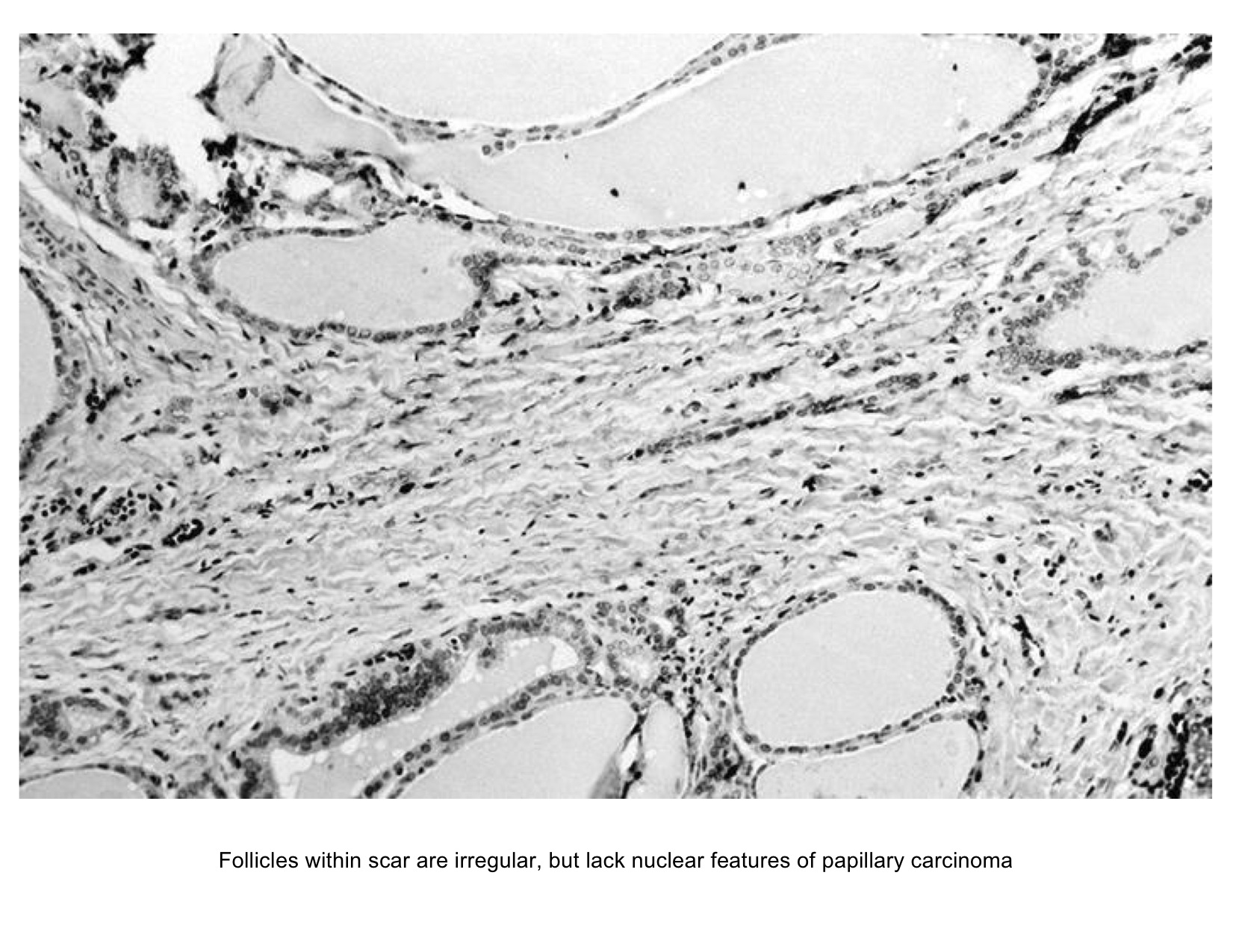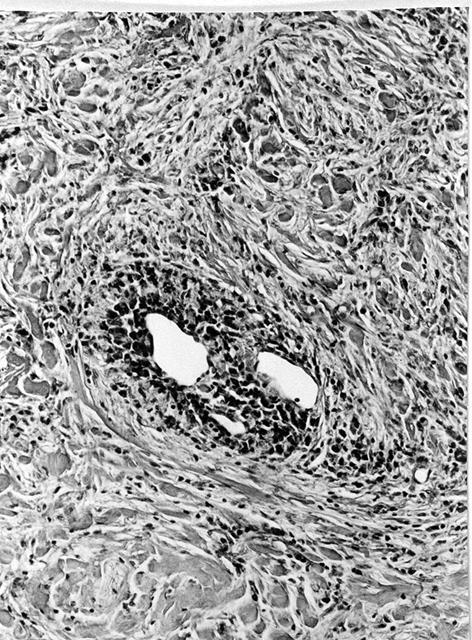Riedel's thyroiditis pathophysiology
|
Riedel's thyroiditis Microchapters |
|
Diagnosis |
|---|
|
Treatment |
|
Case Studies |
|
Riedel's thyroiditis pathophysiology On the Web |
|
American Roentgen Ray Society Images of Riedel's thyroiditis pathophysiology |
|
Risk calculators and risk factors for Riedel's thyroiditis pathophysiology |
Editor-In-Chief: C. Michael Gibson, M.S., M.D. [1]; Associate Editor(s)-in-Chief: Furqan M M. M.B.B.S[2]
Overview
The exact pathogenesis of Riedel's thyroiditis is not fully understood. The presence of thyroid autoantibodies and lymphoid infiltration of the thyroid gland resembling that of Hashimoto's thyroiditis might indicate an autoimmune etiology. It is considered that the infiltrating lymphocytes release cytokines which are responsible for the activation of fibroblasts responsible for the fibrosis. Riedel's thyroiditis is characterized by a replacement of the normal thyroid parenchyma by a dense fibrosis that invades adjacent structures of the neck and extends beyond the thyroid capsule. This makes the thyroid gland stone-hard and fixed to adjacent structures. A shared mechanism with retroperitoneal fibrosis and sclerosing cholangitis has been suggested.
Pathophysiology
The control, synthesis, and release of the thyroid hormone is usually controlled by hypothalamus and pituitary gland.[1][2]
|
 |
Pathogenesis
The exact pathogenesis of Riedel's thyroiditis is not fully understood. The presence of thyroid autoantibodies and lymphoid infiltration of the thyroid gland resembling that of Hashimoto's thyroiditis might indicate an autoimmune etiology.[3]
- It is considered that the infiltrating lymphocytes (CD4+ and CD8+) release cytokines which are responsible for the activation of fibroblasts responsible for the fibrosis.[4]
- Riedel's thyroiditis is characterized by a replacement of the normal thyroid parenchyma by a dense fibrosis that invades adjacent structures of the neck and extends beyond the thyroid capsule.This makes the thyroid gland stone-hard and fixed to adjacent structures.[5]
- Tissue eosinophilia and Major basic protein (MBP) identified in the thyroid gland on the histopathological analysis are also thought to play a role in the proliferation of fibroblasts.[6]
- A shared mechanism with retroperitoneal fibrosis and sclerosing cholangitis is also suggested.[7]
Hypotheses
The following hypotheses regarding the pathogenesis of Riedel's thyroiditis have been proposed:[8]
The Systemic Autoimmune Hypothesis
According to this theory, Riedel's thyroiditis (RT) might be a primary disease of fibroblasts triggered by autoimmune stimuli.[8][9][10][11][12][13]
- It is proposed that the endothelial cells release oxidized low-density lipoprotein from atheromatous plaques following the injury resulting in an allergic hypersensitivity reaction.
- The natural consequence of this hypothesis is that the antigen initiating fibrosis is not localized within the thyroid but is affected secondarily by a systemic fibroinflammatory process.
- Thyroid follicular cells, peri-thyroid muscular cells, or intrathyroidal endothelial cells express antigens, cytokines, or adhesion molecules that might contribute to local activation of the disease. The evidence of a perivascular concentration of inflammatory cells in RT (occlusive phlebitis) might support the theory that the allergic process first involves blood vessels.
- Once the allergic reaction has started, a heavy inflammatory cell population such as B and T lymphocytes, plasma cells, monocytes, and eosinophils infiltrate tissues and produce several cytokines.
- The role of eosinophils in this context probably is central. When eosinophils migrate into the tissues involved by the disease, they degranulate and release cationic toxins into connective tissue including Major basic protein (MBP), eosinophil cationic protein, eosinophil peroxidase, and eosinophil-derived neurotoxin.
- Eosinophils also release cytokines, the most important of which are transforming growth factor β, transforming growth factor α, and granulocyte-macrophage colony-stimulating factor. This stimulates fibroblast proliferation that finally causes fibrosis.
The Genetic Hypothesis
This hypothesis was proposed for the multifocal fibrosclerosis which is associated with Riedel's thyroiditis.[14]
- The basis of this hypothesis was a report of multifocal fibrosclerotic disease in two brothers, whose parents were first cousins. They developed different combinations of the multifocal fibrosclerotic disease and a familial multifocal fibrosclerosis was hypothesized.
- It was thought that genetic factors might have played a partial role in an enzymatic defect in the tryptophan → serotonin → 5-hydroxyindolacetic acid pathway. However, such a relationship has never been proven, and the siblings described remain the only case of familial multifocal fibrosclerosis reported in the literature.
The Intrathyroidal hypothesis
Riedel's thyroiditis is associated with Hashimoto's thyroiditis and de Quervain's thyroiditis.[15]
- It is proposed that Riedel's thyroiditis might represent a late fibrotic stage of subacute or chronic thyroiditis. The fundamental concept of this theory is that the fibrosing process of RT is specific to the thyroid gland.
The Pharmacologic Hypothesis
This hypothesis is also proposed primarily for multifocal fibrosclerosis. As Riedel's thyroiditis is associated with multifocal fibrosclerosis this theory might explain the indirect association of Riedel's thyroiditis with drugs.[8][16]
- The production of fibrosis by the drugs might be determined by an increased serum serotonin concentration through competitive inhibition at the serotonin receptor level and a reaction of hypersensitivity causing vasculitis and plasma exudation resulting in fibrosis.
- Although drugs have been found to cause multi organ fibrosis, there are no reports regarding medication induced Riedel's thyroiditis. This theory might explain the indirect association of Riedel's thyroiditis with drugs as Riedel's thyroiditis is associated with multifocal fibrosclerosis.
Associated Conditions
Riedel's thyroiditis is associated various other autoimmune conditions including:[4][17][18][19][20][16]
- Graves’ disease
- Hashimoto’s thyroiditis
- Multifocal idiopathic fibrosclerosis
- Addison’s disease
- Pernicious anemia
- Type 1 diabetes
Gross Pathology
On gross pathology the following findings are characteristic of Riedel's thyroiditis:[21]
Microscopic Pathology
On microscopic histopathological analysis the following findings are usually seen:[22][8]
- Destruction of thyroid follicle by inflammatory cells
- Inflammatory cells including lymphocytes, plasma cells, and eosinophils in a dense matrix of hyalinized connective tissue
- Fibrous tissues and invasion of surrounding structures
Gallery
-
Histology of Riedel's thyroiditis (Image courtesy of AFIP and PathologyOutlines.com; http://www.pathologyoutlines.com/topic/thyroidriedel.html )
-
Histology of Riedel's thyroiditis (Image courtesy of AFIP and PathologyOutlines.com; http://www.pathologyoutlines.com/topic/thyroidriedel.html )
-
Histology of Riedel's thyroiditis (Image courtesy of AFIP and PathologyOutlines.com; http://www.pathologyoutlines.com/topic/thyroidriedel.html )
References
- ↑ De Groot LJ, Chrousos G, Dungan K, Feingold KR, Grossman A, Hershman JM, Koch C, Korbonits M, McLachlan R, New M, Purnell J, Rebar R, Singer F, Vinik A, Rousset B, Dupuy C, Miot F, Dumont J. "Thyroid Hormone Synthesis And Secretion". PMID 25905405.
- ↑ Kirsten D (2000). "The thyroid gland: physiology and pathophysiology". Neonatal Netw. 19 (8): 11–26. doi:10.1891/0730-0832.19.8.11. PMID 11949270.
- ↑ Schwaegerle SM, Bauer TW, Esselstyn CB (1988). "Riedel's thyroiditis". Am. J. Clin. Pathol. 90 (6): 715–22. PMID 3057862.
- ↑ 4.0 4.1 Zimmermann-Belsing T, Feldt-Rasmussen U (1994). "Riedel's thyroiditis: an autoimmune or primary fibrotic disease?". J. Intern. Med. 235 (3): 271–4. PMID 8120524.
- ↑ Cho MH, Kim CS, Park JS; et al. (2007). "Riedel's thyroiditis in a patient with recurrent subacute thyroiditis: a case report and review of the literature". Endocr. J. 54 (4): 559–62. PMID 17603227.
- ↑ "Tissue eosinophilia and eosinophil degranulation in Riedel's invasive fibrous thyroiditis | The Journal of Clinical Endocrinology & Metabolism | Oxford Academic".
- ↑ De Boer WA (1993). "Riedel's thyroiditis, retroperitoneal fibrosis, and sclerosing cholangitis: diseases with one pathogenesis?". Gut. 34 (5): 714. PMC 1374200. PMID 8504980.
- ↑ 8.0 8.1 8.2 8.3 Papi G, LiVolsi VA (2004). "Current concepts on Riedel thyroiditis". Am. J. Clin. Pathol. 121 Suppl: S50–63. PMID 15298150.
- ↑ Heufelder AE, Goellner JR, Bahn RS, Gleich GJ, Hay ID (1996). "Tissue eosinophilia and eosinophil degranulation in Riedel's invasive fibrous thyroiditis". J. Clin. Endocrinol. Metab. 81 (3): 977–84. doi:10.1210/jcem.81.3.8772560. PMID 8772560.
- ↑ Noguchi H, Kephart GM, Colby TV, Gleich GJ (1992). "Tissue eosinophilia and eosinophil degranulation in syndromes associated with fibrosis". Am. J. Pathol. 140 (2): 521–8. PMC 1886427. PMID 1739138.
- ↑ Gleich GJ, Adolphson CR (1986). "The eosinophilic leukocyte: structure and function". Adv. Immunol. 39: 177–253. PMID 3538819.
- ↑ Gleich GJ, Frigas E, Loegering DA, Wassom DL, Steinmuller D (1979). "Cytotoxic properties of the eosinophil major basic protein". J. Immunol. 123 (6): 2925–7. PMID 501097.
- ↑ Seibold JR, Giorno RC, Claman HN (1990). "Dermal mast cell degranulation in systemic sclerosis". Arthritis Rheum. 33 (11): 1702–9. PMID 2242067.
- ↑ Comings DE, Skubi KB, Van Eyes J, Motulsky AG (1967). "Familial multifocal fibrosclerosis. Findings suggesting that retroperitoneal fibrosis, mediastinal fibrosis, sclerosing cholangitis, Riedel's thyroiditis, and pseudotumor of the orbit may be different manifestations of a single disease". Ann. Intern. Med. 66 (5): 884–92. PMID 6025229.
- ↑ Ewing J (1919). Neoplastic Diseases 2nd edition. Saunders; 1922:908.
- ↑ 16.0 16.1 Drieskens O, Blockmans D, Van den Bruel A, Mortelmans L (2002). "Riedel's thyroiditis and retroperitoneal fibrosis in multifocal fibrosclerosis: positron emission tomographic findings". Clin Nucl Med. 27 (6): 413–5. PMID 12045432.
- ↑ Drury MI, Sweeney EC, Heffernan SJ (1974). "Invasive fibrous (Riedel's) thyroiditis". Ir Med J. 67 (14): 388–90. PMID 4413980.
- ↑ "Chronic thyroiditis: A case showing features of both riedel's and hashimoto's thyroiditis - Merrington - 1948 - British Journal of Surgery - Wiley Online Library".
- ↑ Hines RC, Scheuermann HA, Royster HP (1970). "Invasive Fibrous (Riedel's) Thyroiditis With Bilateral Fibrous Parotitis". JAMA: 869–871. doi:10.1001/jama.1970.03170310147054.
- ↑ "Riedel's Thyroiditis: A Clinical Review | The Journal of Clinical Endocrinology & Metabolism | Oxford Academic".
- ↑ "Riedel's Thyroiditis | American Journal of Clinical Pathology | Oxford Academic".
- ↑ "Redirecting".


